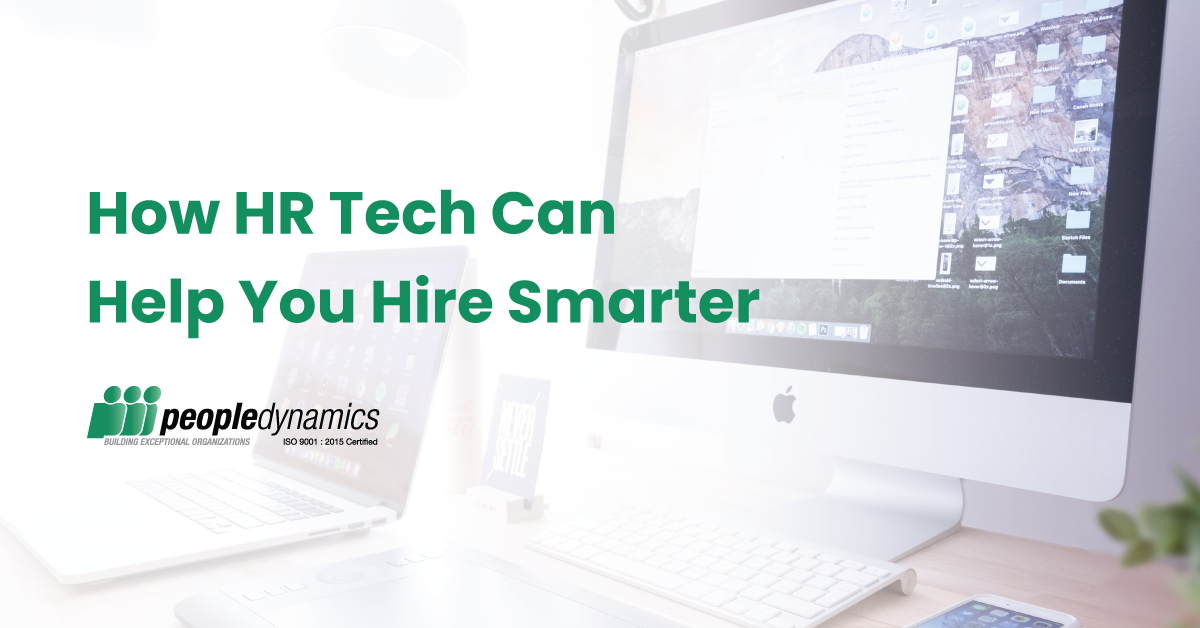The hiring process frequently conjures up images of resumes and interviews, job offers, and contract negotiations—but not technology. An often overlooked aspect, technology plays a major role in hiring, retaining, and managing people.
Human resources (HR) tech is often invisible, quietly working behind the scenes to improve the candidate experience as well as the entire hiring process for recruiters.
HR tech has come a long way in the last decade thanks to major advances in artificial intelligence (AI), machine learning, and more. Its job is to remove some of the burdens from your teams to make hiring faster, more effective, and less stressful.
Read on to learn how HR tech is changing the hiring game to identify stronger candidates, retain employees, and even improve company culture.
The many faces of HR tech
“HR technology” is an umbrella term that describes the software, platforms, and associated hardware that automate the human resources function in companies.
It includes payroll and compensation platforms, talent acquisition and management, workforce analytics, performance management programs, and benefits administration—in short, all elements HR teams leverage to refine the functions of their organization.
Because HR intersects with several groups in a business, there are a lot of software and platforms that help with various functions to support every element of HR. Some of the most popular HR tech categories are listed below.
Applicant tracking systems
An applicant tracking system (ATS) is a form of HR software that acts as a database for job applicants. (It’s like Salesforce, but for job seekers.) Companies of all sizes use ASTs to organize, search, and communicate with large groups of applicants.
The primary goal of an ATS is to smooth out operations for recruiters and hiring managers by making searching easier and automating some hiring functions to save time and avoid human error.
Most ATSs follow the basic process of “knocking out” applicants who are not a fit for the position at that time. This involves asking questions like checkbox-style yes or no questions or short answer responses to determine whether or not an application advances to the next stage.
In the next phase, an ATS will parse and store resume information so hiring teams can easily search by keyword or other data pieces like education, skills, work experience, or even location.
With an ATS, it’s easy to view applications at a glance and set automatic rankings to demonstrate which applicants most closely match a job description for a position you want to fill. This streamlines the determination of who to invite to an interview and who won’t advance.
Succession planning software
Succession planning software helps organizations prepare for turnover by identifying and developing employees to fill key roles. Organizations invest valuable time and resources into hiring the right candidates, but they often fail to plan ahead for when these people move on or where they could move internally when employees leave.
Companies can use succession planning software throughout the entire employee life cycle to support teams’ needs and accommodate growth and healthy turnover.
Succession planning software helps identify employees who are best suited to moving up the ranks and backfilling positions as they become available. It can also reveal positions that may soon be vacant by pinpointing employees nearing retirement so you can plan ahead.
Recruitment marketing tools
Recruitment marketing tools help you market your company as an employer of choice to job seekers.
Companies implement recruitment marketing platforms to help internal recruiting teams attract and source job candidates to apply for their open roles. These platforms typically offer a variety of features designed to assist recruiting marketing efforts such as:
- Social recruiting tools
- Job distribution features
- Candidate relationship management capabilities
These platforms market job openings and allow companies to engage with potential candidates by nurturing interest and encouraging them to apply. Some also offer tools for identifying candidates at recruitment events like a job fairs.
HR departments and recruiters often leverage recruitment marketing platforms to build talent pipelines, similar to how a salesperson would build their pipeline of potential customers. This enables organizations to increase the quality and volume of applicants.
Candidate relationship management
Candidate relationship management is the other “CRM,” and offers many of the same benefits as a customer relationship management system.
This HR version of CRM is the structured process of maintaining a healthy, positive relationship with past, current, and potential candidates.
This is important to ensure you have a consistent pool of hiring talent to draw from whenever a position opens up.
CRMs make it easy to see what roles candidates previously applied for and enable seamless communication with candidates to keep them apprised of current vacancies and more.
How tech can assist the hiring process
With no shortage of tools and technologies available to support hiring, companies can leverage that tech at each stage of the process.
Streamline communications
Clear communication is at the core of an efficient hiring process. It moves the procedure along and is critical to the candidate experience—regardless of whether a candidate is a top choice or they fail to make it past the initial screening.
As an employer, communicating with everyone who has applied for a job with your company leaves a big impression and helps you build relationships with potential employees for future opportunities.
An ATS can send pre-written communications to applicants throughout the hiring process, with some systems offering automated communication features as well. These can include emails to confirm receipt of an application all the way to communicating when a job posting has closed and thanking applicants for considering a role with your company.
Since an ATS can show you what actions have been taken on a candidate’s application, you can keep track of communications and make sure your applicants stay informed and receive the right messages at the right time.
“Score” applicants
Thanks to HR tech, you can quickly see who’s most suited to a particular role without spending hours manually scanning resumes and cover letters. AI-powered technology relies on machine learning and other data to scan applications and “score” candidates based on how closely their application matches your job description and advertisement.
For example, assume the top score a candidate can receive is 10 (meaning their application is a perfect match to the job description advertised in your job posting). The scoring feature may look at five criteria: education, years of experience, skills, keywords, and geographic location. The feature will read applications for these criteria and score each one against your job posting.
Applicants who have the appropriate education, experience, skills, and keywords and are in the right geographic location will score higher than those who don’t meet those requirements.
Impartial hiring
As humans, we make mistakes and suffer from inherent bias. Because of this, both organizations and applicants have raised the question of fairness in the hiring process.
According to the University of Massachusetts Amherst, “traditional hiring practices are plagued with bias.” In their report Using Technology to Increase Fairness in Hiring, they define a hiring process as fair “…when candidates are not intentionally singled out for discriminatory treatment and when the overall effect of the selection process does not disproportionately disadvantage members of any one demographic group.”
Technology can introduce greater objectivity into hiring by removing the often unconscious bias in the way selection committees score applicants. It also increases impartiality by not taking into account names, ages, or other potential bias markers.
Improve diversity and inclusion
Related to fairness is the issue of diversity, equity, and inclusion within organizations.
Having a more diverse and equitable workforce yields greater success for companies, but achieving this can be a challenge—unless you have the right tech.
Diversity and inclusion (D&I) technologies can attract a varied workforce, reduce unconscious bias in the recruitment process, and facilitate the selection of suitable candidates. This can be achieved through the use of D&I technology such as:
- Text evaluation to minimize bias in job postings
- Job posting outreach tools with recognized networks of diverse candidates
- Automation capabilities that remove names or other identifying information to prevent bias in the recruitment process (e.g., removing traditionally female or cultural/ethnic names)
- Video-based, AI-powered solutions that assess interviewers’ potential biases by analyzing speech and body movements during interviews with candidates
- Resume analysis for evidence of skills matching existing job descriptions to broaden the potential candidate pool and facilitate more objective matching within your CRM or ATS
Scan social media
Social media scanning has become a standard in the hiring process. A 2018 survey by CareerBuilder revealed over half of companies discovered content on social media that caused them not to hire a candidate. Another one-third of employers reported social media content led them to reprimand or terminate an existing employee.
However, digging into each candidate’s social media in search of keywords and phrases that could present a red flag is time-consuming.
Enter: AI social media-screening tools. These tools look for set keywords and phrases and highlight them for recruiters to review.
Using these tools can prevent messy situations down the line, such as if a new hire shares content that doesn’t align with the company’s values. This automation also saves time during the recruitment process.
Assess the best talent and fit
Although an ATS can score resumes and cover letters against the requirements for a job advertisement, it can’t detect lies or uncover resume padding.
An estimated 40% of people lie on their resumes, and three out of four employers say they’ve caught a lie on someone’s resume. The most common fibs relate to education, previous dates of employment, and past salaries, as well as exaggerating numbers, making up titles, or lying about technical abilities and language fluency. So, how do you catch these deceptions?
Use tests and assessments to verify applicants’ skills and determine cultural fit before you make an offer.
HR teams and hiring managers are increasingly employing tests and assessments to determine the right candidates to hire.
Testing and assessment platforms can help companies confirm that applicants possess the skills listed on their resumes, and also shed light on important personality traits that impact their work style, relationships, and more.
How tech can help retain hires
Besides facilitating the hiring process, HR technology can help you retain hires and better manage your employees for a happier workforce.
This will help your hiring process by showcasing good results, as well as ensuring your team isn’t overloaded with open positions due to churn.
Workforce management
Workforce management software (WFM) refers to desktop and mobile programs that help companies plan, manage, and track employee work, including labor requirements, scheduling, and paid time off.
Companies can also use WFM platforms to forecast labor demand, create and assign employee schedules, track attendance, and even report on workforce performance and handle benefits administration.
Performance analytics
Performance analytics tools benchmark and evaluate employee performance.
HR departments and leadership teams can use performance analytics platforms or WFM platforms with analytics tools to examine the hiring, training, and overall performance of teams to generate the best output from them.
These analytics help businesses construct a digital workplace with an immersive and coherent approach to output that supports increasingly diverse roles and performance improvement. Companies can also use these metrics to identify top performers, pinpoint areas for improvement, and craft corrective plans to support underperforming team members.
Performance analytics play an important role in the creation and execution of reward and recognition programs as well, which helps to improve employee satisfaction, motivation, and productivity.
Benefits administration
A benefits administration software is a system that HR departments, managers, and individual employees can use to manage workplace benefits.
These platforms cut out the traditional paperwork inherent to benefits and compensation by automating elements like employees’ benefits eligibility, elections, and enrollment in medical, dental, and other ancillary options.
Companies can also use this system to request and approve paid time off (PTO) or expenses, track goals, and more.
Benefits administration software increases transparency for employees and gives them greater control over their benefits, as well as helps managers keep track of their teams’ PTO more efficiently.
Tests and assessments
Tests and assessments can identify employees who are best suited to move into leadership or managerial roles, as well as pinpoint what motivates team members to perform well. They help you understand what drives your current employees and what roles they would excel in.
As a result, you can increase employee productivity and satisfaction, nurture existing talent, and retain new hires by opening doors to promotion within your organization.
Wrapping up — Use HR tech to hire smarter
The right HR tech solutions can optimize your hiring process, from screening to impartiality through to retention. You may not need every tool mentioned here; the combination you choose will depend on your analysis of the weaknesses in your hiring process.
Select the right tools to upgrade your hiring process and leverage greater efficiency and results that will be felt company-wide.




